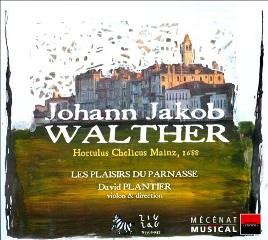Johann Jakob Walther - Hortulus Chelicus Mainz, 1688 (2006)
Johann Jakob Walther - Hortulus Chelicus Mainz, 1688 (2006)

Suite N°9 En Do Mineur / C Minor / C Moll 1 Preludio 3:31 2 Allemanda 2:12 3 Corrente 1:29 4 Sarabanda 1:26 5 Giga 2:02 Suite N°8 En Mi Majeur / E Major / E Dur 6 Preludio 2:34 7 Aria - Variatio 0:52 8 Sarabanda - Variatio 3:24 9 Giga 1:06 10 Aria N°14 En Sol Mineur / G Minor / G Moll 6:48 Suite N°6 En Si Mineur / B Minor / H Moll 11 Preludio 4:13 12 Allemanda 2:38 13 Corrente - Variatio 1:48 14 Sarabanda - Variatio 2:38 15 Giga 1:29 16 Finale 1:37 Suite N°20 En Mi Mineur / E Minor / E Moll 17 Preludio 2:28 18 Allemanda 1:31 19 Corrente - Variatio 1:49 20 Sarabanda - Variatio 3:12 21 Giga 1:04 Serenata A Un Coro Di Violini, Organo Tremolante, Chitarrino, Piva, Due Trombe E Timpani, Lira Todesca E Harpa Smorzata Per Un Violino Solo N°28 En Ré Majeur / D Major / D Dur 22 Coro Di Violini 0:54 23 Organo Tremolante 1:12 24 Aria A Violino Solo - Chitarrino - Piva 2:26 25 Timpani - Tromba - Bicinio Di Due Trombe 2:26 26 Violini E Violino Solo - Lira Todesca - Adagio : Violino Solo E Coro 2:28 27 Harpa Smorzata 2:36 28 Finale Con Archi 0:41 29 Passagagli N°7 En Ré Mineur / D Minor / D Moll 9:39 Maya Amrein (cello) Shizuko Noiri (theorbo) Andrea Marchiol (clavecin, organ) Les Plaisirs du Parnasse David Plantier (violin, director)
Now the first thing to say is do not get this Walther muddled up with Johann Gottfried Walther (1684-1748) who was a distant relative of Bach and preliminary and organist. Our Walther is primarily a violinist and obviously a superb one at that. This collection ‘Hortulus Chelicus’ is primarily of violin music accompanied as it were, by a backing group, a lute or theorbo, or a harp, sometimes a chamber organ or sometimes a chitarrone; whatever the performers fancy adding into the mix. Nevertheless this is, more often than not, virtuoso violin music.
The main weight of the performances falls squarely on the shoulders of David Plantier who has been making quite a name for himself on the baroque violin in the years since 1997 when he graduated from the Schola Cantorum. I find his playing quite ravishing, but I did turn the treble down a little as the recording, to my taste, seemed to be overly bright. He is superbly supported by Maya Amrein, Andrea Marchiol and Shizuki Noiri.
Walther’s printed collection is one of the most outstanding of its period but, until now, very little known. Think, for example, of the significance of Biber’s ‘Rosary Sonatas’ and of Corelli’s Op. 6. This publication is in that league.
This is not just virtuoso music written by a baroque Paganini; it can be also very expressive and even good fun. The most expressive pieces tend to be the opening Preludes, which can be quite substantial. For an example listen to the wonderful start of the E minor Sonata. The Aria in G minor is also a most melodic and emotional piece. The happiest items tend to be the closing ‘Giga’ movements and the ‘Correntes’. The form of the five suites selected here are similar but there is some variety. They are in five movements and include four dances, sometimes with variations. These are an Allemande, a Corrente, a Sarabande and a Giga.
The ‘Serenata’ is a highly original work and falls into six movements. To give it its full title it is for ‘Violino solo, Chittarrino, Due Trombe e Timpani, Lira tedesca e Harpa smorzata’. It’s worth saying immediately that these mysterious instruments like timpani are merely imitated by the composer and not specially imported for this curious work. In the ‘Aria-Chitarrino – Piva’ he creates a violin-and-drone effect which reminds me of Biber’s ‘Battaglia’ mixed with a repeated pizzicato passage. The timpani is imitated by double-stopping percussively on the bass strings of the cello. The next movement is a gentler ‘Tedesco’ which is twice interrupted by a raucous peasant dance complete with drone. Harp effects are created by the theorbo and harpsichord. The strings are especially convincing in this regard in the ‘Harpa smorzata’ movement as they pluck their way through in a mood of light-hearted frolic.
I cannot speak too highly of the performances from David Plantier and his group, particularly the colour and expression these musicians generate. It has been worth the wait for this music to be presented to the general listening public. These are pieces that need to be played with aplomb and style if they are it to heard to full benefit. That is exactly the treatment they receive here.
The disc comes with a detailed booklet the font of which is somewhat microscopic. There are notes by David Plantier on the composer and the music. Watch out though: there is no pocket for the booklet within the folding cardboard case and it can easily fall out.
Walther in his preface to the collection stated that he hoped that his music "would charm a public seeking melodic pleasure". Well without a doubt he certainly achieves this. This is fine and highly civilized music and we are fortunate indeed that it has been so wonderfully researched and executed. ---Gary Higginson, www.musicweb-international.com
download (mp3 @192 kbs):
yandex mediafire uloz.to mega 4shared cloudmailru gett








